
Content
| “We¹ve got a great agenda lined up for this SuperMeet,” said Daniel Berube, co-producer and head of the Boston Final Cut Pro User Group. “Europe deserves the best and we think we have delivered. We will have the latest on Final Cut Studio delivered by Apple¹s Paul Saccone. We are bringing a little of Hollywood too, with Director Jeffrey Nachmanoff (screenwriter of The Day After Tomorrow) and Film Editor, Billy Fox (Hustle and Flow, Black Snake Moan) who will discuss how Final Cut Studio helped bring the recently released film, “Traitor” starring Don Cheadle to life. We will also have Miguel de Olaso from Spain showing off Red Camera footage and workflow, the new Infinity Camera from Grass Valley/Thomson, the Sundance Audience Award winning documentary “Fields of Fuel,” Production Premium from Adobe and Final Cut Pro tips and tricks. It¹s going to be a great show.” “We¹ve produced these events as part of Macworld in San Francisco and NAB in Las Vegas for the last seven years,” says Michael Horton, co-producer of the SuperMeet and head of the Los Angeles Final Cut Pro User Group. “And for seven years we¹ve wanted to bring the SuperMeet to Europe. Now we will.” The First Annual IBC FCPUG SuperMeet, Sunday, September 14, 2008. Where: Westergasfabriek – Gashouder, Klönneplein 3, Amsterdam Felix Bopp, editor-in-chief |
DNA can predict European region of origin
DNA now also makes it possible to predict from which region in Europe a person originates. Researchers from Erasmus MC, in an international collaborative study, have found the link between genetic diversity and geographic origin of Europeans. The study, partly financed by the Netherlands Forensic Institute (NFI), provides an important new basis for forensic applications. The scientific journal Current Biology published the research results on 7 August.
Researchers from the Department of Forensic Molecular Biology of the Erasmus MC, in an international collaborative study under the leadership of Prof. Dr. Manfred Kayser, have discovered that autosomal (non-sex-specific) DNA characteristics can predict from which region in Europe a man or woman originates.
Previously it was only possible to distinguish people according to their continental origin on the basis of DNA markers and sometimes additionally, only for men, the region within continents, using DNA characteristics found on the Y-chromosome. Disadvantage of this Y-chromosome test is that it can only be carried out on men and that any possible mixing of ancestors from different continents or regions is not traceable. The latter can result in misleading conclusions on the region of origin in forensic applications.
According to Prof. Dr. Manfred Kayser: “The new method is at present based on a large number of autosomal DNA markers. These can only be determined from relatively large amounts of undamaged DNA material, for example, in forensic cases in which an unknown person is to be identified on the basis of DNA from a body or parts of a body. The next step is to determine the minimum number of autosomal DNA markers necessary to predict the European region of origin. This should in the future allow making a reliable decision also when only DNA of limited quantity and quality is available.”
Prof. Dr. Ate Kloosterman , senior forensic researcher at the NFI says: “The results of this study offer interesting opportunities for obtaining in the future more information from traces of biological material that have, for example, been obtained from a criminal offender. This is not only of importance in recent cases but also in ‘cold cases’ where the information on geographic origin can be significant. Prior to this, the method will have to be made suitable for forensic practice as often little DNA or sometimes partially broken DNA is available.
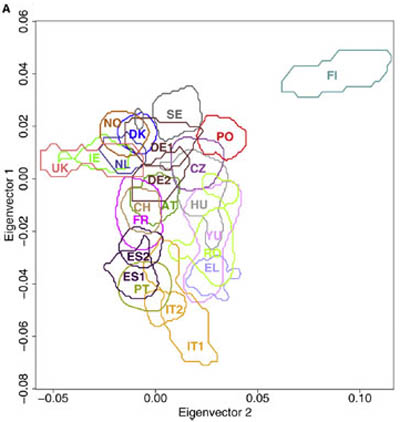
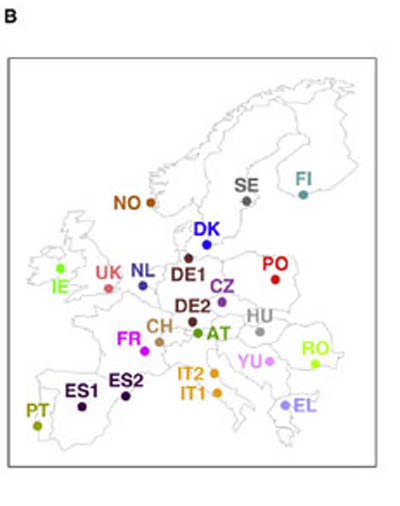
Genetically speaking, Finns and Italians are the most atypical Europeans. There is a large degree of overlap between other European ethnicities, but not up to the point where they would be indistinguishable from each other. Which means that forensic scientists now can use DNA to predict the region of origin of otherwise unknown persons (provided they are of European heritage)
The discovery that autosomal (i.e. non-gender-related) aspects of DNA may be used to predict regional European provenance of unkown individuals was made by prof. dr. Manfred Kayser’s team of forensic molecular biologists. In a press release, the Erasmus UMC stated that this might potentially be helpful in resolving so-called ‘cold cases’.
The genetic map of Europe was compiled by comparing DNA samples from 23 populations in Europe (picture B). Those populations were then placed on the ‘genetic’ map according to their similarity, with the vertical axis denoting differences from south to north, and the horizontal one from west to east. The larger the area assigned to a population, the larger the genetic variation within that population.
When compared to the actual map, the populations kinda sorta maintain their relative position to each other. Two observations spring to mind immediately: the fact that most populations overlap so intimately with their neighbours. And that Finland doesn’t. Some other observations:
- The extent of genetic variation is greater north to south than east to west. This may be a result of the way Europe was colonized by modern humans, i.e. from the south, in three successive waves of migration (45,000 years ago, where before there had only been Neanderthals; 17,000 years ago, after the last Ice Age; and 10,000 years ago, with the advent of farming techniques from the Middle East).
- The isolation of Finnish genetics can be explained by the fact that they were at one time a very small population, preserving its genetic idiosyncrasies as it expanded.
- The relative isolation of Italian genetics is probably due to the Alps, providing a geographic barrier to the free and unhindered flow of population to and from Italy… Although Hannibal, the Celtic and Germanic influence in Italy’s north and of course the expansion of the Roman Empire would seem to contradict this.
- Yugoslav genetic variation is quite large (hence the big pink blob), and overlaps with the Greek, Romanian, Hungarian, Czech and even the Italian ones.
- There is surprisingly little overlap between the northern and southern German populations, each of which has more in common with their other neighbours (Danish/Dutch/Swedish in the northern case, Austrian/Swiss/French in the other one).
- The Polish population is quite eccentric as well, only significantly overlapping with the Czech one (and only minimally with the northern German one).
- The Swiss population is entirely subsumed by the French one, similarly, the Irish population almost doesn’t show any characteristics that would distinguish it from the British one.
- British and Irish insularity probably explains why so much of their genetic area is not shared with their closest European cousins, i.c. the Norwegian / Danish / Dutch cluster.
Next Event

Organised by Final Cut Pro User Group Los Angeles
Sunday, September 14, 2008
Registration: 17:00-19:00
Presentations: 19:00-22:00
After Party: 22:00-01:00
This event is open to the public. Seating is first come first serve.
Where: Westergasfabriek – Gashouder, Klönneplein 3, Amsterdam
Event Management & Catering by SONARIS:
Mediterranean food, beer, wine, champagne, non-alcoholic and tropical drinks.
The event is supported byApple, Adobe, Blackmagicdesign, Thomson, the Westergasfabriek and many more ..
Club of Amsterdam blog
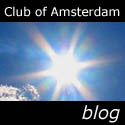
| Club of Amsterdam blog http://clubofamsterdam.blogspot.com September 10: EFMN correspondents’ day 2008: Weak Signals in Foresight September 10: IBC FCPUG SuperMeet June 9 : Pakistan in the 21st Century: Vision 2030 May 24: Beyond Innovation May 24: What future coal? |
News about the Future

| Exoskeleton for granpa Finding ways to assist and care for the growing elderly population in many developed countries is a growing problem. One challenge is to work out how to improve the strength and utility of ageing limbs. Yoshiyuki Sankai at the University of Tsukuba near Tokyo, has developed an exoskeleton for a single arm that can do just that. The device consists of a tabard worn over the shoulders with a motorised exoskeleton for one arm attached. The exoskeleton senses the angle, torque and nerve impulses in the arm and then assists the user to move his or her shoulder and elbow joints accordingly |
 Ice Sauna The Snow Room is a ten-degrees-below-zero “spa” that will be making its way to luxury hotels in Antalya, Turkey. The room will be offered to those hotel guests who have had enough of the blazing sun and unbearable heat, and are looking for a way to cool down – at minus ten degrees the Snow Room will be just the place |
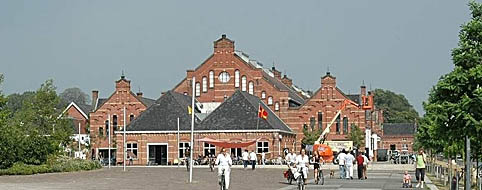
Westergasfabriek Amsterdam
If you’re looking for an adventurous place in Amsterdam, then the Westergasfabriek Culture Park is worth a visit. Art and culture form the basis of this down-to-earth industrial complex close to the centre of Amsterdam. The new energy is tangible for everyone who visits for work, play, exercise, entertainment or events.
Just about anything goes in these historic buildings; from a photo shoot to major audience events, from weddings to exclusive product presentations. The venues available for a temporary hire are: the magnificent circular Gasometer (2500 m2), the Transformer House with its sacred mood (700 m2), the impressive Purification Hall (1200 m2), the intimate Machine Building with chapel (340 m2) and the small Eastern Meter House (60 m2), furnished as a meeting room. The outdoor spaces such as the quayside, the larger meadow or the gardens of the park can also be used for events.
The Westergasfabriek is freely accessible all day. From early in the morning, there’s fresh bread and fine coffee at the Baker’s Shop (open every day) and the Espresso Factory (open tue – sun). There are various galleries and shops, Pacific Parc cafe/restaurant/dancing (open everyday) and the food-design studio Proef (open: fri-sun). The Ketelhuis Cinema (open everyday) shows the latest films and in the Flex Bar (open thu – sun) you can dance late in the night. Opening soon: The WestergasTerras for drinks, dinner, parties & salsa near the wetlands. The modern park surrounding the site offers plenty of space, peace and nature; for a picknick, to throw a frisby or a pleasant walk. You are most welcome.
Westergasfabriek / Pazzanistraat 41 / 1041 DB Amsterdam /
T: + 31 (0) 20 5860710 / F: + 31 (0) 20 6813062 /
E info@westergasfabriek.nl I www.westergasfabriek.com

Stanford’s ‘autonomous’ helicopters teach themselves to fly
Stanford computer scientists have developed an artificial intelligence system that enables robotic helicopters to teach themselves to fly difficult stunts by watching other helicopters perform the same maneuvers.
The result is an autonomous helicopter than can perform a complete airshow of complex tricks on its own.
The stunts are “by far the most difficult aerobatic maneuvers flown by any computer controlled helicopter,” said Andrew Ng, the professor directing the research of graduate students Pieter Abbeel, Adam Coates, Timothy Hunter and Morgan Quigley.
The dazzling airshow is an important demonstration of “apprenticeship learning,” in which robots learn by observing an expert, rather than by having software engineers peck away at their keyboards in an attempt to write instructions from scratch.
Stanford’s artificial intelligence system learned how to fly by “watching” the four-foot-long helicopters flown by expert radio control pilot Garett Oku. “Garett can pick up any helicopter, even ones he’s never seen, and go fly amazing aerobatics. So the question for us is always, why can’t computers do things like this?” Coates said.
Computers can, it turns out. On a recent morning in an empty field at the edge of campus, Abbeel and Coates sent up one of their helicopters to demonstrate autonomous flight. The aircraft, brightly painted Stanford red, is an off-the-shelf radio control helicopter, with instrumentation added by the researchers.
For five minutes, the chopper, on its own, ran through a dizzying series of stunts beyond the capabilities of a full-scale piloted helicopter and other autonomous remote control helicopters. The artificial-intelligence helicopter performed a smorgasbord of difficult maneuvers: traveling flips, rolls, loops with pirouettes, stall-turns with pirouettes, a knife-edge, an Immelmann, a slapper, an inverted tail slide and a hurricane, described as a “fast backward funnel.”
The pièce de résistance may have been the “tic toc,” in which the helicopter, while pointed straight up, hovers with a side-to-side motion as if it were the pendulum of an upside down clock.
“I think the range of maneuvers they can do is by far the largest” in the autonomous helicopter field, said Eric Feron, a Georgia Tech aeronautics and astronautics professor who worked on autonomous helicopters while at MIT. “But what’s more impressive is the technology that underlies this work. In a way, the machine teaches itself how to do this by watching an expert pilot fly. This is amazing.”
Writing software for robotic helicopters is a daunting task, in part because the craft itself, unlike an airplane, is inherently unstable. “The helicopter doesn’t want to fly. It always wants to just tip over and crash,” said Oku, the pilot.
To scientists, a helicopter in flight is an “unstable system” that comes unglued without constant input. Abbeel compares flying a helicopter to balancing a long pole in the palm of your hand: “If you don’t provide feedback, it will crash.”
Early on in their research, Abbeel and Coates attempted to write computer code that would specify the commands for the desired trajectory of a helicopter flying a specific maneuver. While this hand-coded approach succeeded with novice-level flips and rolls, it flopped with the complex tic-toc.”
It might seem that an autonomous helicopter could fly stunts by simply replaying the exact finger movements of an expert pilot using the joy sticks on the helicopter’s remote controller. That approach, however, is doomed to failure because of uncontrollable variables such as gusting winds.
When the Stanford researchers decided their autonomous helicopter should be capable of flying airshow stunts, they realized that even defining their goal was difficult. What’s the formal specification for “flying well?” The answer, it turned out, was that “flying well” is whatever an expert radio control pilot does at an airshow.
So the researchers had Oku and other pilots fly entire airshow routines while every movement of the helicopter was recorded. As Oku repeated a maneuver several times, the trajectory of the helicopter inevitably varied slightly with each flight. But the learning algorithms created by Ng’s team were able to discern the ideal trajectory the pilot was seeking. Thus the autonomous helicopter learned to fly the routine better – and more consistently – than Oku himself.
During a flight, some of the necessary instrumentation is mounted on the helicopter, some on the ground. Together, they continuously monitor the position, direction, orientation, velocity, acceleration and spin of the helicopter in several dimensions. A ground-based computer crunches the data, makes quick calculations and beams new flight directions to the helicopter via radio 20 times per second.
The helicopter carries accelerometers, gyroscopes and magnetometers, the latter of which use the Earth’s magnetic field to figure out which way the helicopter is pointed. The exact location of the craft is tracked either by a GPS receiver on the helicopter or by cameras on the ground. (With a larger helicopter, the entire navigation package could be airborne.)
There is interest in using autonomous helicopters to search for land mines in war-torn areas or to map out the hot spots of California wildfires in real time, allowing firefighters to quickly move toward or away from them. Firefighters now must often act on information that is several hours old, Abbeel said.
“In order for us to trust helicopters in these sort of mission-critical applications, it’s important that we have very robust, very reliable helicopter controllers that can fly maybe as well as the best human pilots in the world can,” Ng said. Stanford’s autonomous helicopters have taken a large step in that direction, he said.
http://heli.stanford.edu
Recommended Book
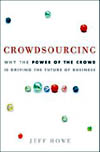
Crowdsourcing: Why the Power of the Crowd Is Driving the Future of Business
by Jeff Howe
“The amount of knowledge and talent dispersed among the human race has always outstripped our capacity to harness it. Crowdsourcing corrects that -but in doing so, it also unleashes the forces of creative destruction.” – From Crowdsourcing
First identified by journalist Jeff Howe in a June 2006 Wired article, “crowdsourcing” describes the process by which the power of the many can be leveraged to accomplish feats that were once the province of the specialized few. Howe reveals that the crowd is more than wise – it’s talented, creative, and stunningly productive. Crowdsourcing activates the transformative power of today’s technology, liberating the latent potential within us all. It’s a perfect meritocracy, where age, gender, race, education, and job history no longer matter; the quality of work is all that counts; and every field is open to people of every imaginable background. If you can perform the service, design the product, or solve the problem, you’ve got the job.
But crowdsourcing has also triggered a dramatic shift in the way work is organized, talent is employed, research is conducted, and products are made and marketed. As the crowd comes to supplant traditional forms of labor, pain and disruption are inevitable.
Jeff Howe delves into both the positive and negative consequences of this intriguing phenomenon. Through extensive reporting from the front lines of this revolution, he employs a brilliant array of stories to look at the economic, cultural, business, and political implications of crowdsourcing. How were a bunch of part-time dabblers in finance able to help an investment company consistently beat the market? Why does Procter & Gamble repeatedly call on enthusiastic amateurs to solve scientific and technical challenges? How can companies as diverse as iStockphoto and Threadless employ just a handful of people, yet generate millions of dollars in revenue every year? The answers lie within these pages.
The blueprint for crowdsourcing originated from a handful of computer programmers who showed that a community of like-minded peers could create better products than a corporate behemoth like Microsoft. Jeff Howe tracks the amazing migration of this new model of production, showing the potential of the Internet to create human networks that can divvy up and make quick work of otherwise overwhelming tasks. One of the most intriguing ideas of Crowdsourcing is that the knowledge to solve intractable problems – a cure for cancer, for instance – may already exist within the warp and weave of this infinite and, as yet, largely untapped resource. But first, Howe proposes, we need to banish preconceived notions of how such problems are solved.
The very concept of crowdsourcing stands at odds with centuries of practice. Yet, for the digital natives soon to enter the workforce, the technologies and principles behind crowdsourcing are perfectly intuitive. This generation collaborates, shares, remixes, and creates with a fluency and ease the rest of us can hardly understand. Crowdsourcing, just now starting to emerge, will in a short time simply be the way things are done.
EFMN correspondents’ day 2008: Weak Signals in Foresight
This year’s European Foresight Monitoring Network (EFMN) correspondents’ day takes place in Brussels on the 3rd – 4th November. The network comprises European policy professionals, foresight experts and practitioners as well as analysts of science, technology and innovation related issues. . The aim of the EFMN correspondent’s day is to infuse the so far largely virtual EFMN community with real life. The event itself strikes a good balance between presentations of interesting foresight content and the opportunity to network with like minded professionals. Attendance is free of charge.
This year’s event theme is weak signals. This topic receives increasing attention from policy-makers and firms to yield results in practice. A mix of presentations is planned covering the methodological challenges of identifying weak signals as well as presentations of case studies from weak signal studies done for firms and policy-makers.
The event takes place at the Brussels University Foundation starting at 12:00 on the 3rd and ending the following day the 4th November at 15:00.
A detailed programme will be sent to all participants after registration has closed.
Highlights of event
Weak Signals
· Keynote speaker: Dr Elina Hiltunen on weak signals research (Futures Research Finland / Nokia)
· Anssi Tervonen on weak signals at timber firm M-real (Datarangers, Finland)
· Weak signals identification in policy.
EFMN activities
· Key Messages from the EFMN Journal Special published 2008.
· Opinion poll and discussion on weak signals
· Results of EFMN mapping and Issue analysis 2008
· Presentation of recent EFMN briefs production and website tutorial
Presentation by Pierre Valette; Head of Unit DG-RTD/L.2: Commission Roadmap
Networking / self-presentation:
· Opening with lunch buffet
· Informal dinner arranged at the conference location
· Option to present own work and ideas in Pecha Kucha style at conference

Sichuan Food
Reguliersdwarsstraat 35, 1017BK Amsterdam
tel. +31 (0)20 626 9327, fax +31 (0)20 627 7281
Open daily from 17.30 to 23.00
http://sichuan-food.orientalrestaurants.nl
“First Michelin star Chinese restaurant in Europe. Top Chinese kitchen and quality service. The Peking duck is amazing. The restaurant owner is a member of the Order of Oranje.” – Six Star Society
“Considered one of the area’s top Chinese restaurants, this small venue entertains a host of adherents. Although it boasts a somewhat formal atmosphere, it isn’t in the least bit off-putting. The cuisine is of good quality too, judiciously spiced and rife with fresh ingredients. Peking duck is excellent, and an array of chicken, beef, pork, and seafood dishes also please local palates. Set menus take care of those who desire the full dining experience, and the value is generally quite satisfying.” – 10Best Restaurant Reviews
“Not far from Rembrandtplein, this restaurant (honored several times over by restaurant guides) prepares authentic Chinese food, most notably Szechuan specialties as its name indicates. Inside, the Chinese decor is sombre, drawing attention to a mysteriously blue-lit aquarium of exotic fish.” – Thalys
Futurist Portrait: James Lovelock
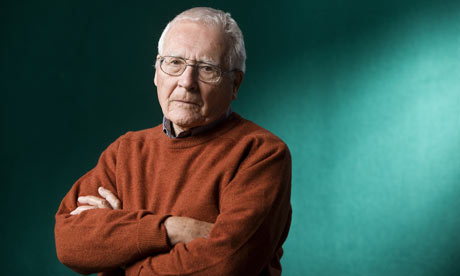
Dr James Ephraim Lovelock, CH, CBE, FRS (born 26 July 1919) is an independent scientist, author, researcher, environmentalist, and futurist who lives in Cornwall, in the south west of England. He is known for proposing the Gaia hypothesis, in which he postulates that the Earth functions as a kind of superorganism.
A lifelong inventor, Lovelock has created and developed many scientific instruments, some of which have been adopted by NASA in its programme of planetary exploration. It was while working for NASA that Lovelock developed the Gaia Hypothesis, for which he is most widely known.
In early 1961, Lovelock was engaged by NASA to develop sensitive instruments for the analysis of extraterrestrial atmospheres and planetary surfaces. The Viking program that visited Mars in the late-1970s was motivated in part to determining whether Mars supported life, and many of the sensors and experiments that were ultimately deployed aimed to resolve this issue. During work towards this program, Lovelock became interested in the composition of the Martian atmosphere, reasoning that many life forms on Mars would be obliged to make use of it (and, thus, alter it). However, the atmosphere was found to be in a stable condition close to its chemical equilibrium, with very little oxygen, methane, or hydrogen, but with an overwhelming abundance of carbon dioxide. To Lovelock, the stark contrast between the Martian atmosphere and chemically-dynamic mixture of that of our Earth’s biosphere was strongly indicative of the absence of life on the planet. However, when they were finally launched to Mars, the Viking probes still searched (unsuccessfully) for extant life there.
Lovelock invented the electron capture detector, which ultimately assisted in discoveries about the persistence of CFCs and their role in stratospheric ozone depletion. After studying the operation of the Earth’s sulfur cycle, Lovelock and his colleagues developed the CLAW hypothesis as a possible example of biological control of the Earth’s climate.
Lovelock was elected a Fellow of the Royal Society in 1974. He served as the president of the Marine Biological Association (MBA) from 1986 to 1990, and has been a Honourary Visiting Fellow of Green College, Oxford since 1994. He has been awarded a number of prestigious prizes including the Tswett Medal (1975), an ACS chromatography award (1980), the WMO Norbert Gerbier Prize (1988), the Dr A.H. Heineken Prize for the Environment (1990) and the RGS Discovery Lifetime award (2001). He became a CBE in 1990, and a Companion of Honour in 2003.
An independent scientist, inventor, and author, Lovelock works out of a barn-turned-laboratory in Cornwall.
CFCs
After the development of his electron capture detector in the late 1960s, Lovelock was the first to detect the widespread presence of CFCs in the atmosphere. He found a concentration of 60 parts per trillion of CFC-11 over Ireland and, in a partially self-funded research expedition in 1972, went on to measure the concentration of CFC-11 from the northern hemisphere to the Antarctic aboard the research vessel RV Shackleton. He found the gas in each of the 50 air samples that he collected but, not knowing of the risk that chlorine posed to the ozone layer, incorrectly concluded that the level of CFCs constituted “no conceivable hazard”.
However, the experiment did provide the first useful data on the ubiquitous presence of CFCs in the atmosphere. The damage caused to the ozone layer by the photolysis of CFCs was later discovered by Frank Rowland and Mario Molina. After hearing a lecture on the subject of Lovelock’s results, they embarked on research that resulted in the first published paper that suggested a link between stratospheric CFCs and ozone depletion in 1974, and later shared the 1995 Nobel Prize in Chemistry for their work.
Gaia
First formulated by Lovelock during the 1960s as a result of work for NASA concerned with detecting life on Mars, the Gaia hypothesis proposes that living and non-living parts of the earth form a complex interacting system that can be thought of as a single organism. Named after the Greek goddess Gaia, the hypothesis postulates that the biosphere has a regulatory effect on the Earth’s environment that acts to sustain life.
While the Gaia Hypothesis was readily accepted by many in the environmentalist community, it has not been fully accepted within the scientific community. Among its more famous critics are the evolutionary biologists Richard Dawkins and Ford Doolittle. These (and other) critics have questioned how natural selection operating on individual organisms can lead to the evolution of planetary-scale homeostasis
Lovelock has responded to these criticisms with models such as Daisyworld, that illustrate how individual-level effects can translate to planetary homeostasis. However, as Earth Systems Science is still in its infancy, it is not yet clear how well Daisyworld applies to the full complexity of the Earth’s biosphere and climate. For instance, climatologists believe that the models used by Lovelock were overly-sensitive to organisms.
Nuclear power
Lovelock has become concerned about the threat of global warming from the greenhouse effect. In 2004 he caused a media sensation when he broke with many fellow environmentalists by pronouncing that “only nuclear power can now halt global warming”. In his view, nuclear energy is the only realistic alternative to fossil fuels that has the capacity to both fulfill the large scale energy needs of mankind while also reducing greenhouse emissions. He is an open member of Environmentalists for Nuclear Energy.
In 2005, against the backdrop of renewed UK government interest in nuclear power, Lovelock again publicly announced his support for nuclear energy, stating, “I am a Green, and I entreat my friends in the movement to drop their wrongheaded objection to nuclear energy”. Although these interventions in the public debate on nuclear power are recent, his views on it are longstanding. In his 1988 book The Ages of Gaia he states:
“I have never regarded nuclear radiation or nuclear power as anything other than a normal and inevitable part of the environment. Our prokaryotic forebears evolved on a planet-sized lump of fallout from a star-sized nuclear explosion, a supernova that synthesised the elements that go to make our planet and ourselves.”
In The Revenge of Gaia (2006), where he puts forward the concept of sustainable retreat, Lovelock writes:
“A television interviewer once asked me, ‘But what about nuclear waste? Will it not poison the whole biosphere and persist for millions of years? ‘ I knew this to be a nightmare fantasy wholly without substance in the real world… One of the striking things about places heavily contaminated by radioactive nuclides is the richness of their wildlife. This is true of the land around Chernobyl, the bomb test sites of the Pacific, and areas near the United States’ Savannah River nuclear weapons plant of the Second World War. Wild plants and animals do not perceive radiation as dangerous, and any slight reduction it may cause in their lifespans is far less a hazard than is the presence of people and their pets… I find it sad, but all too human, that there are vast bureaucracies concerned about nuclear waste, huge organisations devoted to decommissioning power stations, but nothing comparable to deal with that truly malign waste, carbon dioxide.”
On 30 May 2006, Lovelock told the Australian Lateline television program: “Modern nuclear power stations are useless for making bombs”. This view may be based on fact that plutonium-239 from the nuclear reactor of a power plant is contaminated with a significant amount of plutonium-240, complicating its use in nuclear weapons. It is easier to enrich uranium than to separate 240Pu from 239Pu to produce weapons-grade material, although even reactor-grade plutonium can in fact be used in weapons eg. dirty bombs. Friends of the Earth Australia responded: “Lovelock’s claim that nuclear power plants cannot be used for weapons production is false, irresponsible and dangerous. A typical nuclear power reactor produces about 300 kilograms of plutonium each year, enough for 30 nuclear weapons”
Climate and mass human mortality
Writing in the British newspaper The Independent in January 2006, Lovelock argues that, as a result of global warming, “billions of us will die and the few breeding pairs of people that survive will be in the Arctic where the climate remains tolerable” by the end of the 21st century. He has been quoted in The Guardian that 80% of humans will perish by 2100 AD, and this climate change will last 100,000 years.
He further predicts, the average temperature in temperate regions will increase by as much as 8°C and by up to 5°C in the tropics, leaving much of the world’s land uninhabitable and unsuitable for farming, with northerly migrations and new cities created in the Arctic. He predicts much of Europe will become uninhabitable having turned to desert and Britain will become Europe’s “life-raft” due to Britain’s stable temperature from being surrounded by the ocean. He suggests that “we have to keep in mind the awesome pace of change and realise how little time is left to act, and then each community and nation must find the best use of the resources they have to sustain civilisation for as long as they can”.
He partly retreated from this position in a September 2007 address to the World Nuclear Association’s Annual Symposium, suggesting that climate change would stabilise and prove survivable, and that the Earth itself is in “no danger” because it would stabilise in a new state. Life, however, might be forced to migrate en masse to remain in habitable climes.
Ocean Pipes proposal
In September 2007, Lovelock and Chris Rapley proposed the construction of ocean pipes “100 to 200 metres long, 10 metres in diameter and with a one-way flap valve at the lower end for pumping by wave movement” to pump water up from below the thermocline to “fertilize algae in the surface waters and encourage them to bloom”. The intention of this scheme is to accelerate the transfer of carbon dioxide from the atmosphere to the ocean by increasing primary production and enhancing the export of organic carbon (as marine snow) to the deep ocean. The idea is theoretical, and the authors note that it “may fail, perhaps on engineering or economic grounds”, and that “the impact on ocean acidification will need to be taken into account”.
The proposal attracted widespread media attention], although also criticism. Commenting on the proposal, Corinne Le Quéré, a University of East Anglia researcher, said “It doesn’t make sense. There is absolutely no evidence that geoengineering options work or even go in the right direction. I’m astonished that they published this. Before any geoengineering is put to work a massive amount of research is needed – research which will take 20 to 30 years”. Other researchers have claimed that “this scheme would bring water with high natural pCO2 levels (associated with the nutrients) back to the surface, potentially causing exhalation of CO2”.
A similar scheme to that proposed by Lovelock and Rapley is already being developed by a commercial company
Agenda
| Our next Season Program will be announced soon! September 14 17:00 – 01:o0 The First Annual IBC FCPUG SuperMeet Location: Westergasfabriek – Gashouder , Klönneplein 3, Amsterdam |
Club of Amsterdam Open Business Club
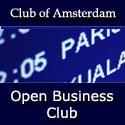
Club of Amsterdam Open Business Club
Are you interested in networking, sharing visions, ideas about your future, the future of your industry, society, discussing issues, which are relevant for yourself as well as for the ‘global’ community? The future starts now – join ouronline platform …



Customer Reviews
Thanks for submitting your comment!